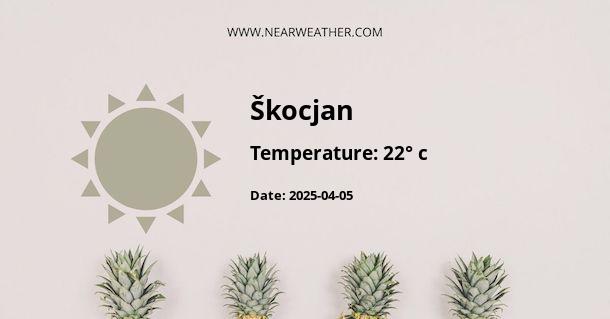Unveiling the Climatic Intricacies of Škocjan, Slovenia
In the embrace of the Karst plateau, Škocjan, a village in Slovenia, is not only renowned for its majestic caves but also for its distinctive climate that makes it a place of meteorological interest. Here, we delve deep into the climatic nuances of Škocjan, equipped with data and expert insights to understand how its weather patterns unfold throughout the year.
Geographical Setting and General Climate Overview
The picturesque village of Škocjan lies within the southeastern part of Slovenia, in an area known as the Dinaric Alps. Its geographical coordinates are approximately 45.66 degrees North and 13.99 degrees East. The Škocjan Caves, a UNESCO World Heritage site, form a unique natural phenomenon that significantly influences the local climate.
"Škocjan's climate is a dance between the Mediterranean, continental, and sub-Mediterranean influences, making it a complex symphony of weather patterns that change with the seasons." - Dr. Luka Novak, climatologist at the University of Ljubljana.
Škocjan experiences a humid subtropical climate (Cfa according to the Köppen climate classification), which is characterized by hot summers and relatively mild winters. Nonetheless, the topography and varying elevations can cause microclimatic variations, especially within the cave systems, which maintain a consistent temperature year-round.
Seasonal Weather Patterns
Spring (March to May)
| Month | Average High (°C) | Average Low (°C) | Precipitation (mm) |
|---|---|---|---|
| March | 12 | 4 | 65 |
| April | 16 | 8 | 70 |
| May | 22 | 13 | 80 |
During spring, Škocjan comes to life with a rich tapestry of blooming flora. Temperatures gradually rise, and the region receives a moderate amount of rainfall, which supports the growth of verdant vegetation. The weather is generally mild but can be changeable with periods of rain and occasional thunderstorms.
Summer (June to August)
| Month | Average High (°C) | Average Low (°C) | Precipitation (mm) |
|---|---|---|---|
| June | 26 | 16 | 90 |
| July | 29 | 18 | 80 |
| August | 28 | 18 | 100 |
The summer season in Škocjan is characterized by warm to hot temperatures and high humidity. Proximity to the sea contributes to the occasional influx of cooler air, offering brief respite from the heat. This season also brings the highest precipitation of the year, with frequent and at times severe thunderstorms.
Autumn (September to November)
- September – crisper air with temperatures ranging from 15°C to 22°C, rainfall at approximately 90 mm.
- October – noticeable cooling with average highs around 18°C and lows near 10°C; precipitations decrease to around 70 mm.
- November – transition to colder weather with average highs around 12°C and lows at 6°C; rainfall can exceed 100 mm, marking this as a wet month.
Autumn witnesses a gradual cooling trend as the lush landscapes of Škocjan transform with a palette of oranges and yellows. Rainfall is consistent and can occasionally lead to foggy conditions, particularly in the valleys and near the cave entrances.
Winter (December to February)
| Month | Average High (°C) | Average Low (°C) | Precipitation (mm) |
|---|---|---|---|
| December | 7 | 1 | 120 |
| January | 6 | 0 | 100 |
| February | 8 | 1 | 80 |
Winter brings cooler temperatures to Škocjan, often laden with moisture from the Adriatic Sea. The region experiences its peak precipitation during December, whilst snowfall is rare but possible, particularly at higher elevations. Despite the chill, the Škocjan Caves offer a constant underground escape with a year-round temperature of about 12°C.
Microclimate Phenomena in the Škocjan Caves
The Škocjan Caves are a masterpiece of nature's architecture, where temperatures remain steadfastly between 10°C and 12°C. The caves create a specific microclimate, which is slightly humid and mostly unaffected by the external weather patterns. This stable environment is crucial for the preservation of a variety of unique subterranean ecosystems that thrive within.
Climate Change Impact on Škocjan
Recent studies have shown signs of climate change affecting the broader region. Experts have observed shifts in precipitation patterns and an increase in extreme weather events. The delicate ecosystems within the Škocjan Cave systems could face challenges due to these changes, as the balance of the karst processes is closely tied to the climate.
Final Observations
Škocjan's climate is an intriguing mix of Mediterranean warmth, continental coolness, and the peculiarities of its topography and karst landscape. It serves as an area of diverse weather patterns, where each season paints a unique picture, and the microclimatic zones within the caves provide a constant natural wonder. Understanding and monitoring its climate is not only significant for predicting weather but also essential for conserving its natural heritage and adapting to the unfolding narrative of climate change.
As we have navigated through the seasonal climate and weather details of Škocjan, it is evident that this Slovenian village, with its world-famous caves, stands as a testament to the intricate and delicate interplay between the earth and its atmosphere.
A - Škocjan's Latitude is 45.906670 & Longitude is 15.291390.
A - Weather in Škocjan is 22° today.
A - Climate Conditions in Škocjan shows clear sky today.
A - Humidity in Škocjan is 34% today.
A - Wind speed in Škocjan is 7.42 km/h, flowing at 190° wind direction. today.
